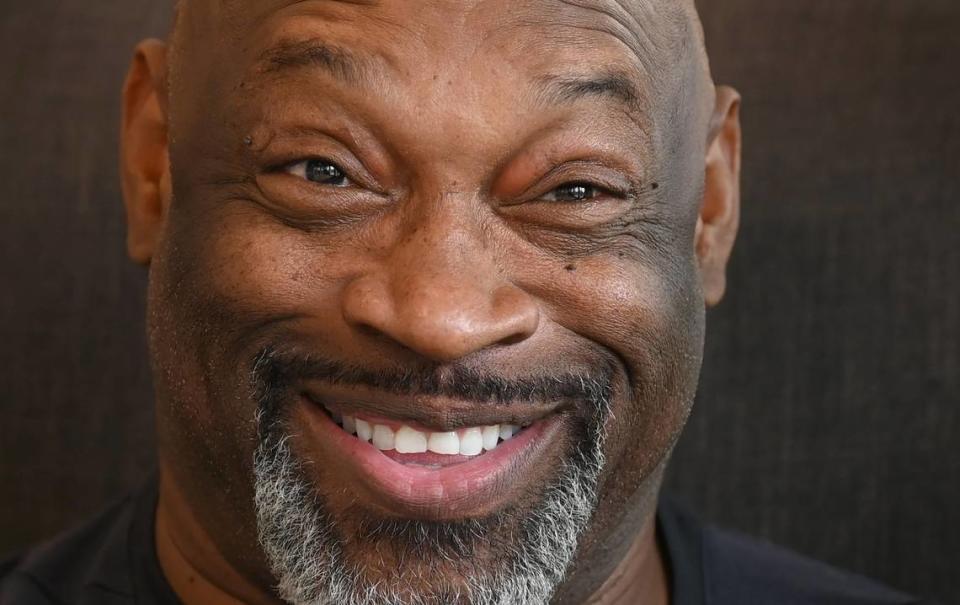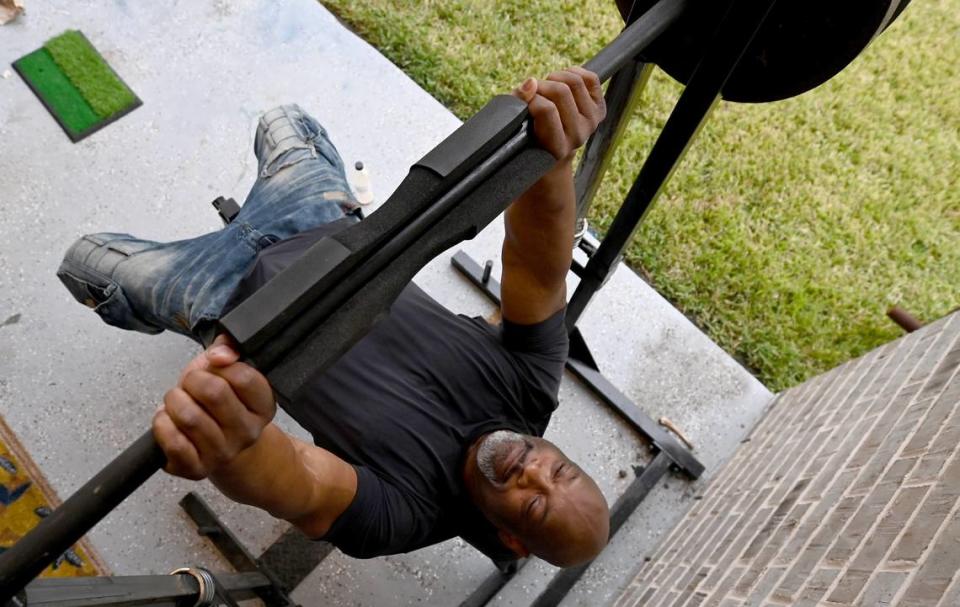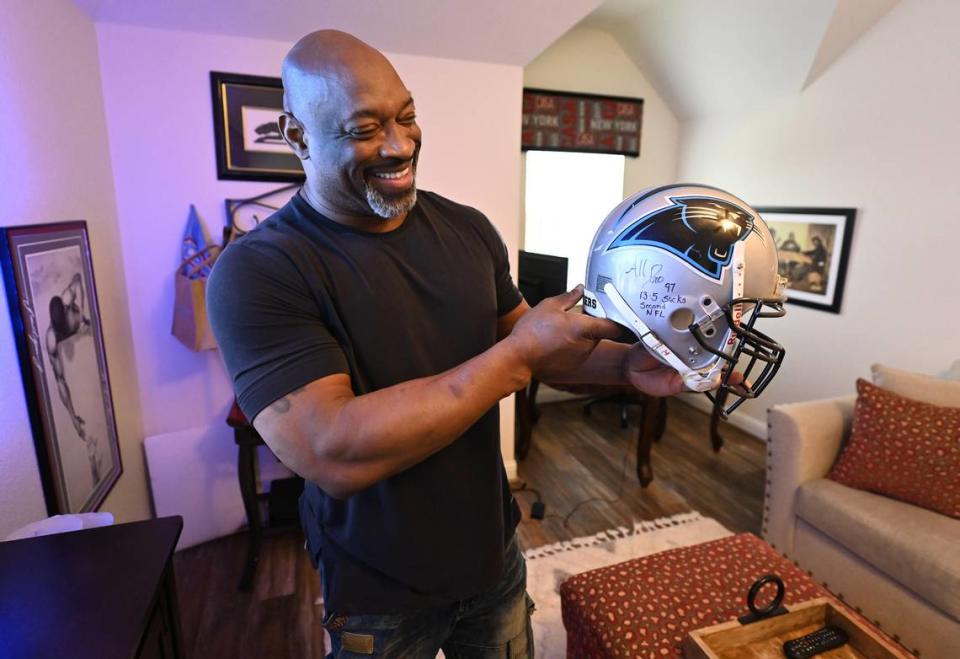Whatever happened to former Panthers star Lamar Lathon? We went to Texas to find out
On the very first two Carolina Panthers teams, in 1995 and 1996, Lamar Lathon was my favorite defensive player to watch.
Sam Mills was steadier. Kevin Greene, once he got there in 1996, was a purer pass rusher. Those two both ended up as Pro Football Hall of Famers.
But Lathon? He was more explosive than either of them. My gosh, what a player.
A 6-foot-3, 265-pound Adonis of an outside linebacker, Lathon looked like he had been the model for the six sculpted Panthers snarling outside what was then known as Ericsson Stadium.
When Lathon hit quarterbacks, they toppled like statues. He hit Dallas wide receiver Michael Irvin so hard three minutes into Carolina’s first-ever playoff game on Jan. 5, 1997 — legally — that he wrecked Irvin’s shoulder, knocked him out of the game and changed the course of one of the most significant wins in Panthers history.
Lathon had 13.5 sacks in a single season in 1996. He was Brian Burns before Brian Burns was born.
“Lamar was a game-wrecker,” Bill Polian, the former Panthers general manager who recruited Lathon to Carolina, said in an interview. “He had incredible power. Incredible explosion. Incredible range. And he was one of the very few linebackers I’ve ever seen who could run right over an offensive tackle.”
And then, Lamar Lathon basically disappeared.
By 1998, his NFL career had been cut short by repeated injuries. He never had a season anything like his Pro Bowl year of 1996 again. He moved back to his home state of Texas.
I heard rumors that he mostly didn’t come out of his house anymore.
A couple of weeks ago, we took a trip to Texas to find him.
34 surgeries
It turned out not to be too hard to locate Lathon. After acquiring his phone number, I texted him and asked what he would think about doing an interview if we came to see him.
“I WOULD LOVE TO,” Lathon wrote back, the capital letters reminding me of the exuberance he so often displayed in Charlotte. After flying to Houston, visual journalist Jeff Siner and I drove 40 miles south to Rosharon, a small Texas town where Lathon lives alone except for his Maltipoo dog, Oso 2, in a subdivision of neatly kept houses.
What we found in a three-hour visit with Lathon at his home was a 54-year-old former linebacker brimming with complicated emotions: About life. About his former-frenemy-turned-lifelong-buddy Greene, who died in 2020. About whether he should have played football at all.
Lathon still looks like he’s in great shape. But he said he has had 34 total surgeries, all due to playing football. That includes 18 procedures on his knees, nine on his shoulders, three on his wrists and a few others on assorted body parts.

Surgery came to be so familiar to Lathon that he developed a routine for it that had the comfort of a pregame ritual: Where to put his Bible, when to say his last prayer before going under anesthesia, the little jokes he would always make to the doctors and nurses.
Football’s cost and rewards
The price of football? That’s something Lathon still thinks about every day when his back is hurting, or his knees won’t let him run, or a word he is trying to think of flutters away. He is part of the first generation of Carolina Panthers, a group of men now entering their mid-to-late 50s, too many of them compromised by the way they made their living and a few of them already deceased.
“If I had known what I know now? No, I wouldn’t have played,” Lathon said at one point during our interview.
At another juncture, however, he allowed as to how he’s proud of what he accomplished in the NFL, and that he enjoys watching his own NFL highlights.
“I still get chills,” Lathon said. “On some plays, I remember exactly what I was thinking.” And, as he said, he made a very good living while living large during his playing career.
“It was still awesome money back then, for the time. But the way that my body feels and what I have to deal with daily …” Lathon said, his voice trailing off.

Lathon said he has turned down multiple interview requests over the past several years but decided to grant this one to let Panthers fans know how he had been doing and how fondly he remembered his best years in Charlotte.
And, Lathon said: “I want people to know I’ve evolved. ... I can remember when and when it was important for me to drive a Bentley. I had three of them, and I drove them for a time period of 10 years. ... And then you realize, you know? That’s not really that important. What’s important is to have peace of mind, and your health.”
‘Lamar always had that star quality’
In early March 1995, the Panthers signed Lathon a week before they signed Mills, making him the highest-paid player on their new defense that would debut when the team did in September.
Lathon had hardly been out of Texas before, growing up in a small Texas town called Wharton, going to college at the University of Houston and playing his first five NFL seasons for the Houston Oilers. He had been raised by a single mother, Alma, who was intent on loving her son and teaching him the value of work. Once, when Lathon begged her to buy him an expensive 10-speed bike, she bought him a lawn mower instead, instructing him to make the money for the bike himself. It took him several months, but he did.
Lathon hit a growth spurt just before high school, and by his freshman year he was 6-foot-3 and 225 pounds. He was a big kid with a big personality, and in many ways that framework has never changed since.
“Lamar always has had that star quality,” said Winslow Oliver, a former Panthers teammate who has known Lathon for more than 30 years. “He’s full of love and joy and always has been. But he can also be intimidating. He intimidated everybody. Other players, his own coaches, GMs — everybody.”

Lathon also sometimes has had to be reined in because of his impatience with less-gifted or motivated teammates. He ripped into Carolina Panthers quarterback Kerry Collins once in a 1996 team meeting, saying Collins’ partying was hurting the team. In high school, he once was temporarily kicked off the squad after going on the team bus after a loss and screaming to everyone exactly what they had just done wrong, including at his head coach for not calling the correct plays.
At the University of Houston, Lathon became the wrecking ball he also was during his best years in the NFL.
“I was the guy who they said, ‘Throw your body on the grenade,’ ” Lathon said. “And that meant to go and destroy people. I just ran through them.”
By the time Greene and Lathon formed the Panthers’ “Salt and Pepper” pass-rushing tandem in 1996, they competed for everything, but mostly sacks and attention. They dressed up once for a Charlotte Observer photo as Santa Claus and also made a $5,000 bet with each other as to who would lead the team in sacks that season.

It was Lathon who delivered the most memorable quote after Carolina whipped Dallas, 26-17, in its first-ever playoff game in the 1996 postseason. He chortled when recalling it during our interview, repeating it word for word from memory.
Then-Cowboys coach Barry Switzer had said during the lead-up to the game on ESPN that Dallas had never traveled as far south as Charlotte for a playoff game.
Since Charlotte is actually northeast of Dallas, Lathon worked himself into a lather over Switzer’s geographically challenged statement, which he perceived as disrespect.
When the game ended, Lathon found a gathering of TV cameras and bellowed: “So now I propose a question for you, Barry Switzer! When you’re sitting at home next week, do you know where Charlotte, North Carolina is now, BABY?!”

A son who won’t play football
While Lathon has mixed feelings about his own nine-year NFL career and whether he should have pursued it, he doesn’t equivocate at all when I asked if he will let his 7-year-old son play football.
“No, never,” Lathon said. “Because he won’t understand the impact physically that it would have on his body. He will only be able to see the glitz and the glamour and the way that the money is. He’ll be able to see that as a means to making a living. But I don’t think anyone in their right mind would want to live with this type of discomfort … the daily grind of getting up and moving around.”
It is that daily grind that keeps Lathon mostly in his house. It turned out that rumor was somewhat true. Lathon lives in a nice house, which is useful, because he’s there almost all the time.
He goes to the grocery store when necessary, and regularly drives the five miles to his girlfriend’s house. And on a very special occasion, he will get on a plane. But mostly, he’s home.
“It’s hell to have a relationship,” Lathon said, “because I don’t like to do anything.”

Lathon lifts weights in his modest backyard gym. He works on his house and his car. He mows his yard and he mows his neighbors’ yards too when he knows they’re out of town. He doesn’t have a regular job. He lives mostly off the money he saved from a career in which he made, he estimates, about $16 million before taxes.
Why doesn’t he go out in public more often?
“I don’t want to see people see me all jacked up and bent over and limping, which goes on for months at a time for me and I’m sure for a whole bunch of other players,” Lathon said. “But the difference between me and those guys is I don’t want to be out there. There’s nothing out there for me. Is this a boring existence? People would say so. But as long as I’ve got some food and I can watch Netflix or something at home every day, it’s OK for me.”
In Charlotte, Lathon was well-known for his “clubbing,” as he labeled it. In Texas, he lives in a cocoon of his own making. He avoids crowds. Over the years, when he has been in them, he has ended up in an occasional fight, he said.
“I don’t really like to even be around a whole bunch of people,” Lathon said. “That’s not important to me anymore. But I also know I don’t do well in those situations, either. I might have a tendency to come unglued sometimes. … I may be a little bit more impatient now, or maybe have a tendency to erupt a little quicker.”

The birth of ‘Salt and Pepper’
In 1996, Greene and Lathon formed what remains the best pass-rushing duo in a single season in Carolina history. They christened themselves “Salt and Pepper,” mostly because Greene was white and Lathon was Black.
“Let’s go put some seasoning on their butts,” they would growl at each other. And though it sounds somewhat corny now and the nickname might not fly in 2022, it worked at the time.
Lathon had 13.5 sacks in 1996, the only time he would reach double digits in sacks. But Greene eclipsed him with 14.5, leading the NFL and winning the $5,000 bet the two of them had as to who would have the most sacks that season.
While Greene was admired by all of his teammates for his relentlessness, other Panthers players were in awe of Lathon’s athleticism.
“I was the Panthers’ third-round draft pick in 1996,” said Oliver, a tailback and punt returner who was seven inches shorter and 75 pounds lighter than Lathon at the time. “And Lamar was indescribably fast. I ran a 4.42 at the scouting combine that year, and I would struggle to beat him in a head-to-head race.”

Lathon and Greene’s combined total of 28 sacks in 1996 remains the highest by any Panthers pass-rushing tandem in a single season. Their competition began in earnest on the first day of the 1996 regular season, when Lathon had three sacks and Greene had two against Atlanta. But it was Greene who had developed more TV-friendly sack dances and also had a more entrenched reputation as a pass rusher. He got the lion’s share of attention following the game, which infuriated Lathon. He thought it had something to do with Greene’s skin color and the media wanting a “great white hope” to emerge in Carolina.
“I busted the Falcons up,” Lathon said. “Kevin had two sacks … I got three sacks, and mine were more devastating and violent, too. … I thought I should be getting some type of headline. Some type of conversation.”
For the next few weeks, Lathon said, he didn’t even speak to Greene. But Greene, determined to make the partnership work, kept praising Lathon’s play when the pass rushers watched film together.
“He’d go, ‘Would you look at that! You are an absolute beast, buddy!’ ” Lathon remembered. “And I’m like, ‘Dude, be quiet.’ But at the same time, Kevin Greene had given me a compliment.”
Greene eventually convinced Lathon they were on the same side. They continued to use the “Salt and Pepper” nickname in front of the media, but they called each other “Double L” and “KG” in private. Lathon had Greene and his wife, Tara, over to his house for dinner, and the Greenes returned the favor.

The two men stayed in contact long after their football careers ended. Greene mentioned Lathon in his Hall of Fame induction speech in 2016, saying: “Lamar made me a better player. I appreciate you, man.”
Greene died at age 58 in 2020 at his home in Destin, Fla. “It broke my heart,” Lathon said.
The two had talked the week before, doing a silly laugh they started every conversation with and signing off with “I love you.”
Too ‘powerful’ for his body
Lathon, Greene and Mills all made the Pro Bowl together as Panthers linebackers in 1996. Mills died of intestinal cancer in 2005. Of the trio, only Lathon remains alive.
While Mills and Greene later would made the Pro Football Hall of Fame as well, Lathon’s career petered out after 1996. Due to a series of injuries, he never played in the NFL again after 1998, when he turned 31 years old.

“Unfortunately, Lamar had a proclivity for getting hurt,” said Polian, the former Panthers’ GM and a Pro Football Hall of Famer himself. “Bob Sanders (the Indianapolis safety who was the NFL’s Defensive Player of the Year in 2007) was the other player like that I can remember. The torque and force they generated, their overwhelming power and quick-twitch abilities: It was beyond any upper range you could imagine. But it was almost like they were too powerful for their own bodies.”
Because of that, Lathon’s career is mostly remembered by people who were there firsthand to see it live. You might see an occasional No. 57 jersey in the Bank of America stands these days, but it’s a rarity.
I asked Brian Burns, the Panthers’ best pass rusher now, the other day if he had ever heard of Lathon. Burns, 24, wasn’t even born when Lathon had his 13.5 sacks in 1996. Burns said he hadn’t, but was intrigued by that 13.5 number. Burns has 10 sacks so far this year, which is his career high.
“Now I’m gonna have to look Lamar Lathon up,” Burns said.

Lathon likes being remembered, but it no longer is as important to him as it once was. He worries now about his health issues. He has seen a therapist for years and believes it helps, but still feels most comfortable in his house, living alone with his dog.
“Do I know for a fact that there is something mentally wrong with me from the way that we play and the impacts that I’ve taken? Yeah, definitely,” Lathon said. “Do I know that it’s unusual that I stay at my house for weeks at a time? Yeah.”
For a while, Lathon gave motivational speeches in the Houston area, often to businesses. During one speech, however, he lost his place and couldn’t figure out quite what to say next. Fearing that might happen again, he never gave another speech.
Lathon said he is concerned about potential brain damage and particularly CTE (chronic traumatic encephalopathy), the devastating neuro-degenerative disease that can’t be definitively detected until a person dies but has been diagnosed in brain examinations of many former NFL players.
“I do worry about CTE,” Lathon said. He particularly worries when he loses track of something.
“Once I was going shopping, and I had to call 911, because I thought somebody stole my car,” Lathon said. “But I had just parked it somewhere else.”
This anecdote reminded me of a conversation I once had with Dr. Robert Cantu, one of the world’s foremost concussion experts — not about Lathon, but about football players in general. The doctor described then the symptoms of many former players he had studied who ended up having CTE due to the thousands of hits to the head they absorbed over the years, whether they were diagnosed with concussions at the time or not.
“The classical case is that you finish your career fine, and then 10-20 years down the road, you start getting cognitive problems,” Cantu said. “And then you start getting some impulsivity problems. Difficulty with a short fuse, difficulty with tolerating unpleasant situations without acting out. Mood issues. Apathy. Depression. Sometimes anxiety. ... There’s no way of knowing for sure if someone has CTE (unless there is a brain exam after death). But if a guy played 13-14 years of ball, he has about 10 times the risk of CTE as somebody who only played five years or less.”

In our interview, Lathon seemed mentally sharp, but once he couldn’t come up with the word “talent” when he was trying to talk about his God-given abilities to play football. That bothered him. He said he has misplaced his driver’s license so often they know him at the local DMV, and that he experiences anxiety sometimes when in conversation.
“Even when I’m talking to you, I get a little nervous,” Lathon said. “I get a little scared because I feel like I’m rambling.”
But Lathon prefers to concentrate on what he has now and finds solace in his Christian faith.
“Listen, I had a whole lot of fun doing what I did,” Lathon said of his football career.
And although he doesn’t want his own son to play football, he still watches the game regularly.
“I’ve started looking at it completely different, though,” Lathon said. “Like, whenever a player gets hit, I’m thinking to myself: ‘Oh, that’s gonna hurt — 20 years from now.’ ”
